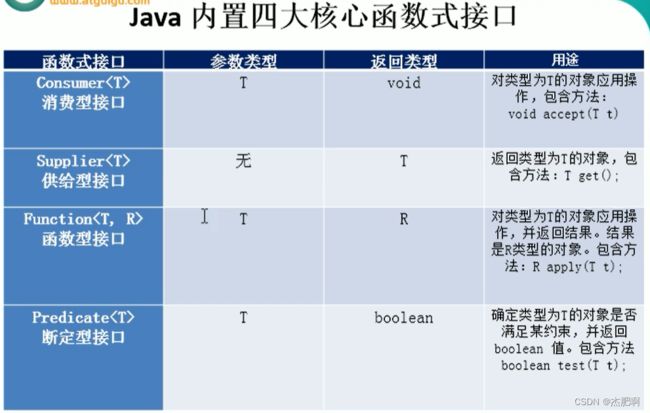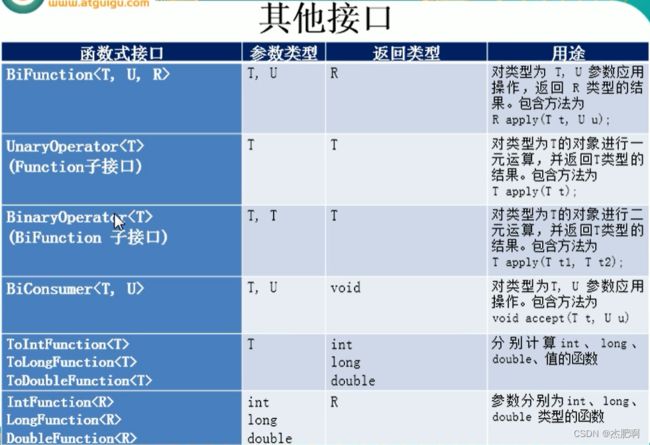【Java】Lambda表达式
Lambda表达式
为什么要用Lambda表达式
Lambda是一个匿名函数,我们可以把Lambda表达式理解为是一段可以传递的代码,将代码像数据一样传递,这样可以写出更简洁、更灵活的代码,作为一个更紧凑的代码风格,使Java语言表达能力得到了提升
实例代码
Lambda表达式最先替代的就是匿名内部类,假设原来我们写一个Comparator比较函数,采用匿名内部类的方式
/**
* 原来使用匿名内部类
*/
public static void test() {
// 使用匿名内部类,重写Intger的 compare方法
Comparator comparator = new Comparator() {
@Override
public int compare(Integer o1, Integer o2) {
return Integer.compare(o1, o2);
}
};
// 传入比较的方法
TreeSet ts = new TreeSet<>(comparator);
}
然后在采用Lambda表达式后
/**
* 使用Lambda表达式解决匿名内部类需要编写大量模板语言的问题
*/
public static void test2() {
Comparator comparator = (x, y) -> Integer.compare(x, y);
// 传入比较的方法
TreeSet ts = new TreeSet<>(comparator);
}
策略设计模式
假设我们现在有一个需求,就是查找出员工里面年龄超过35的,我们使用策略设计模式
/**
* 员工类
*
* @author: 陌溪
* @create: 2020-04-05-12:13
*/
public class Employee {
private String name;
private int age;
private double salary;
// set get
}
然后创建一个接口,这里就是判定条件
/**
* 接口
* @param
*/
public interface MyPredicte {
public boolean test(T t);
}
我们实现这个接口
/**
* 按年龄过滤
*
* @author: 陌溪
* @create: 2020-04-05-12:23
*/
public class FilterEmployeeByAge implements MyPredicte {
@Override
public boolean test(Employee employee) {
return employee.getAge() > 35;
}
}
然后在具体的例子中使用
/**
* 获取当前公司员工年龄大于35
*/
public static void test3() {
List employees = Arrays.asList(
new Employee("张三", 18, 3333),
new Employee("李四", 38, 55555),
new Employee("王五", 50, 6666.66),
new Employee("赵六", 16, 77777.77),
new Employee("田七", 8, 8888.88)
);
MyPredicte mp = new FilterEmployeeByAge();
List emps = new ArrayList<>();
for (Employee emp : emps) {
if(mp.test(emp)) {
emps.add(emp);
}
}
}
当某一天需求变更了,变成需要查找金额大于60000的,那么只需要在编写一个实现类即可
/**
* 按薪资过滤
*
* @author: 陌溪
* @create: 2020-04-05-12:23
*/
public class FilterEmployeeBySalary implements MyPredicte {
@Override
public boolean test(Employee employee) {
return employee.getSalary() > 60000;
}
}
那么具体使用只需要更改为
/**
* 获取当前公司薪资大于60000
*/
public static void test3() {
List employees = Arrays.asList(
new Employee("张三", 18, 3333),
new Employee("李四", 38, 55555),
new Employee("王五", 50, 6666.66),
new Employee("赵六", 16, 77777.77),
new Employee("田七", 8, 8888.88)
);
MyPredicte mp = new FilterEmployeeBySalary();
List emps = new ArrayList<>();
for (Employee emp : emps) {
if(mp.test(emp)) {
emps.add(emp);
}
}
}
这样一个方法,被称为策略设计模式
匿名内部类
使用上面的策略设计模式,我们会发现一个问题,就是每当我需要增加一个条件的时候,就需要增加一个实现类,如果条件多了的话,那么就会有很多实现类,那么为了优化,我们可以采取匿名内部类的方式
/**
* 优化方式,采用匿名内部类的方式
*/
public static void test5() {
List employees = Arrays.asList(
new Employee("张三", 18, 3333),
new Employee("李四", 38, 55555),
new Employee("王五", 50, 6666.66),
new Employee("赵六", 16, 77777.77),
new Employee("田七", 8, 8888.88)
);
// 匿名内部类
filterEmployee(employees, new MyPredicte() {
@Override
public boolean test(Employee employee) {
return employee.getSalary() <= 5000;
}
});
}
直接在内部类中,使用我们的过滤条件
Lambda表达式
/**
* 使用Lambda表达式优化
*/
public static void test6() {
List employees = Arrays.asList(
new Employee("张三", 18, 3333),
new Employee("李四", 38, 55555),
new Employee("王五", 50, 6666.66),
new Employee("赵六", 16, 77777.77),
new Employee("田七", 8, 8888.88)
);
List list = filterEmployee(employees, (e) -> e.getSalary() <= 5000);
list.forEach(System.out::println);
}
或者
/**
* 不使用策略模式
*/
public static void test7() {
List employees = Arrays.asList(
new Employee("张三", 18, 3333),
new Employee("李四", 38, 55555),
new Employee("王五", 50, 6666.66),
new Employee("赵六", 16, 77777.77),
new Employee("田七", 8, 8888.88)
);
employees.stream().filter(e-> e.getSalary() >= 5000).limit(2).forEach(System.out::println);
System.out.println("=========");
employees.stream().map(Employee::getName).forEach(System.out::println);
}
学习Lambda
Lambda表达式基础语法:Java8中引入了一个新的操作符 “->” 该操作符称为箭头操作符 或 Lambda操作符
箭头操作符将Lambda表达式拆分为两部分:
- 左侧:Lambda表达式的参数列表(可以想象成,是上面定义的接口中抽象方法参数的列表)
- 右侧:Lambda表达式中,所需要执行的功能,即Lambda体(需要对抽象方法实现的功能)
语法格式
1、无参,无返回值
格式:
() -> System.out.println(“hello”);
举例:
public static void test() {
Runnable r = new Runnable() {
@Override
public void run() {
System.out.println("hello");
}
};
System.out.println("=========");
Runnable runnable = () -> {
System.out.println("hello lambda");
};
}
JDK1.8以后,调用Lambda外的值,不需要增加final字段,它默认已经添加了final
int n = 10;
Runnable runnable = () -> {
System.out.println("hello lambda" + n);
};
2、有一个参数,有返回值
格式:
(x) -> System.out.println(x);
或 (一个参数时,小括号可以省略不写)
x -> System.out.println(x);
实例:
public static void test2() {
Consumer consumer = (x) -> System.out.println(x);
consumer.accept("我在bilibili");
}
3、有多个参数,一个返回值
/**
* 多个参数,有返回值
*/
public static void test3() {
Comparator comparator = (x, y) -> {
System.out.println("函数式接口");
return Integer.compare(x, y);
};
}
4、有多个参数,只有一条语句
这个时候,可以省略大括号 和 return
/**
* 多个参数,函数体只有一条,并且有返回值时
*/
public static void test4() {
Comparator comparator = (x, y) -> Integer.compare(x, y);
}
类型推断
Lambda中,表达式的参数列表的数据类型可以省略不写,因为JVM编译器通过上下文推断出,数据类型,即“类型推断”。
(Integer x, Integer y) -> Integer.compare(x, y);
但是底层的类型检查还是有的,只是JDK底层帮我们做了类型检查这件事
函数式接口
Lambda表达式需要“函数式接口”的支持
函数式接口:接口中只有一个抽象方法的接口,称为函数式接口,如:
/**
* 函数式接口
*/
public interface MyPredicte {
public boolean test(T t);
}
可以使用注解 @FunctionalInterface 修饰的,则为函数式接口
/**
* 接口,用于解决重复条件
* @param
*/
@FunctionalInterface
public interface MyPredicte {
public boolean test(T t);
}
场景
对一个数进行某种运算
首先创建一个函数式接口
@FunctionalInterface
public interface MyFun {
public Integer getValue(Integer value);
}
然后在定义一个方法,把方法作为参数传递
/**
* 需求:对一个数进行运算
*/
public static void test5() {
Integer value = operation(100, (x) -> x*x);
System.out.println(value);
}
public static Integer operation(Integer num, MyFun myFun) {
return myFun.getValue(num);
}
训练
- 调用Collections.sort()方法,通过定制排序比较两个Employee(先比较年龄比,年龄相同比较姓名),使用Lambda表达式
public static void test() {
List employees = Arrays.asList(
new Employee("张三", 18, 3333),
new Employee("李四", 38, 55555),
new Employee("王五", 50, 6666.66),
new Employee("赵六", 16, 77777.77),
new Employee("田七", 8, 8888.88)
);
Collections.sort(employees, (e1, e2) -> {
if(e1.getAge() == e2.getAge()) {
return e1.getName().compareTo(e2.getName());
} else {
return Integer.compare(e1.getAge(), e2.getAge());
}
});
employees.stream().map(Employee::getName).forEach(System.out::println);
}
Java内置函数接口
Comsumer 消费型接口
格式:Comsumer
传入参数,然后对参数进行操作,没有返回值
/**
* 消费型接口
*/
public static void test() {
happy(1000, (m) -> System.out.println("消费成功:" + m + "元"));
}
public static void happy(double money, Consumer consumer) {
consumer.accept(money);
}
Supplier 供给型接口
格式:Supplier
T get();
传入参数,对参数进行操作,然后有返回值
/**
* 供给型接口,供给功能如何实现
*/
public static void test2() {
List list = getNumList(10, () -> {
Integer a = (int)(Math.random() * 10);
return a;
});
list.stream().forEach(System.out::println);
}
/**
* 产生指定个数的整数
* @param n
* @return
*/
public static List getNumList(Integer n, Supplier supplier) {
List list = new ArrayList<>();
for (int i = 0; i < n; i++) {
list.add(supplier.get());
}
return list;
}
最后输出结果
0
5
9
4
4
3
4
5
0
3
Function 函数型接口
格式:Function
R apply(T t);
/**
* 函数型接口
* Function
*/
public static void test3() {
String str = strHandler("abcdefg", (x) -> {
return x.toUpperCase().substring(0, 5);
});
System.out.println(str);
}
/**
* 需求:用于处理字符串
*/
public static String strHandler(String str, Function function) {
// 使用apply方法进行处理,怎么处理需要具体实现
return function.apply(str);
}
输出结果:
ABCDE
Predicate 断言型接口
格式:Predicate, 用于做一些判断
/**
* 断言型接口(把长度大于3的str过滤出来)
*/
public static void test4() {
List list = Arrays.asList("abc", "abcd", "df", "cgg", "aaab");
List result = strPredict(list, (x) -> x.length() > 3);
result.forEach(item -> {
System.out.println(item);
});
}
/**
* 将满足条件的字符串,放入到集合中
*/
public static List strPredict(List list, Predicate predicate) {
List result = new ArrayList<>();
list.forEach(item -> {
if(predicate.test(item)) {
result.add(item);
}
});
return result;
}
扩展
上述的四大核心接口,并不能被适用于一个特殊的应用场景,只能满足大部分的需求
因为他们对于参数的参入有局限性
同时后面针对这样的情况,后面也使用子接口,进行了解决

